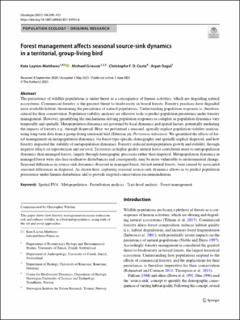| dc.contributor.author | Layton-Matthews, Kate | |
| dc.contributor.author | Griesser, Michael | |
| dc.contributor.author | Coste, Christophe | |
| dc.contributor.author | Ozgul, Arpat | |
| dc.date.accessioned | 2022-03-09T11:34:31Z | |
| dc.date.available | 2022-03-09T11:34:31Z | |
| dc.date.created | 2021-07-02T01:47:47Z | |
| dc.date.issued | 2021 | |
| dc.identifier.citation | Oecologia. 2021, 196 399-412. | en_US |
| dc.identifier.issn | 0029-8549 | |
| dc.identifier.uri | https://hdl.handle.net/11250/2983979 | |
| dc.description.abstract | The persistence of wildlife populations is under threat as a consequence of human activities, which are degrading natural ecosystems. Commercial forestry is the greatest threat to biodiversity in boreal forests. Forestry practices have degraded most available habitat, threatening the persistence of natural populations. Understanding population responses is, therefore, critical for their conservation. Population viability analyses are efective tools to predict population persistence under forestry management. However, quantifying the mechanisms driving population responses is complex as population dynamics vary temporally and spatially. Metapopulation dynamics are governed by local dynamics and spatial factors, potentially mediating the impacts of forestry e.g., through dispersal. Here, we performed a seasonal, spatially explicit population viability analysis, using long-term data from a group-living territorial bird (Siberian jay, Perisoreus infaustus). We quantifed the efects of forest management on metapopulation dynamics, via forest type-specifc demography and spatially explicit dispersal, and how forestry impacted the stability of metapopulation dynamics. Forestry reduced metapopulation growth and stability, through negative efects on reproduction and survival. Territories in higher quality natural forest contributed more to metapopulation dynamics than managed forests, largely through demographic processes rather than dispersal. Metapopulation dynamics in managed forest were also less resilient to disturbances and consequently, may be more vulnerable to environmental change. Seasonal diferences in source-sink dynamics observed in managed forest, but not natural forests, were caused by associated seasonal diferences in dispersal. As shown here, capturing seasonal source-sink dynamics allows us to predict population persistence under human disturbance and to provide targeted conservation recommendations. Spatial PVA · Metapopulation · Perturbation analysis · Trait-level analysis · Forest management | en_US |
| dc.language.iso | eng | en_US |
| dc.publisher | Springer | en_US |
| dc.rights | Navngivelse 4.0 Internasjonal | * |
| dc.rights.uri | http://creativecommons.org/licenses/by/4.0/deed.no | * |
| dc.title | Forest management affects seasonal source-sink dynamics in a territorial, group-living bird | en_US |
| dc.type | Peer reviewed | en_US |
| dc.type | Journal article | en_US |
| dc.description.version | publishedVersion | en_US |
| dc.subject.nsi | VDP::Zoologiske og botaniske fag: 480 | en_US |
| dc.subject.nsi | VDP::Zoology and botany: 480 | en_US |
| dc.source.pagenumber | 399-412 | en_US |
| dc.source.volume | 196 | en_US |
| dc.source.journal | Oecologia | en_US |
| dc.identifier.doi | 10.1007/s00442-021-04935-6 | |
| dc.identifier.cristin | 1919948 | |
| dc.relation.project | Egen institusjon: Norwegian institute for nature research (NINA) | en_US |
| dc.relation.project | Norges forskningsråd: 223257 | en_US |
| dc.relation.project | Egen institusjon: NTNU | en_US |
| cristin.ispublished | true | |
| cristin.fulltext | original | |
| cristin.qualitycode | 2 | |

